


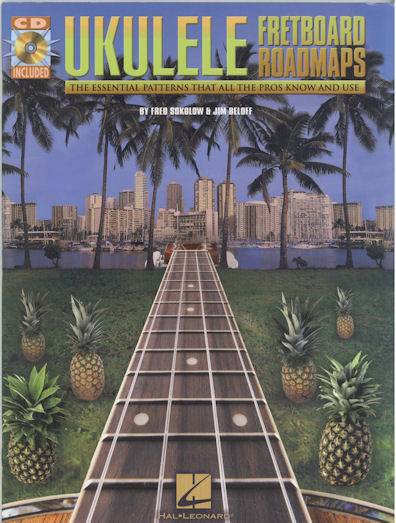
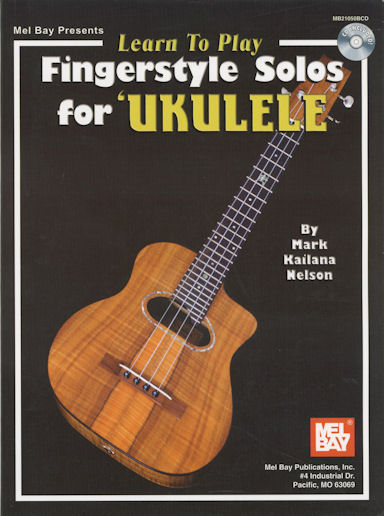



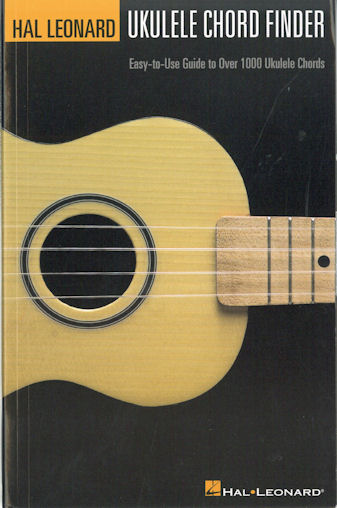
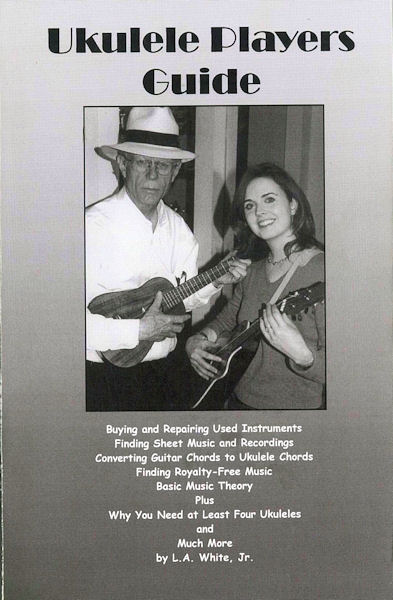
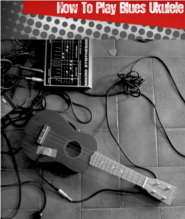
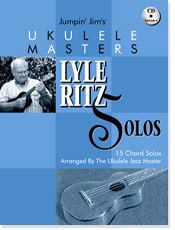

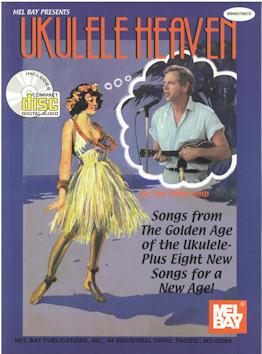

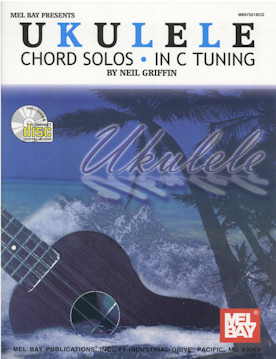



Books, DVDs and learning tools
Like with guitars, there are dozens of resources to help you learn and improve your ukulele playing: books, DVDs, YouTube videos, song books and online tabs, teaching books, chord finders and more. Here are a few I've picked up, with some review notes. You can often simply take a guitar song book and play the chords on a ukulele, appreciating the increase in pitch and reduced number of strings. But often ukulele arrangements take into account the instrument's differences.
There are several different styles of music presentation. Some songs are just lyrics and chords. Others include the musical notation (requiring you to read music). Some include tablature (tab) - the string and fret being identified in an easy-to-read format. I personally prefer chords and tabs because I read music slowly.
The Complete Ukulele Course, by Ralph Shaw (DVD, 2003). You have to like Ralph: he's so bubbly and has so much fun playing and teaching, it's contagious. This is one of those basic packages that start from scratch - what is a ukulele? - and lead the viewer through tuning, simple chords, strumming and the most rudimentary level of playing. By the end, you should be able to play one or two songs.
Calling it complete is a bit misleading, but back when it was first released it was pretty much the only uke training DVD around and covered much more than anyone else did. I donated my copy to the Collingwood library where it is constantly on loan to people who are also taking out one of the library's three ukes.
The DVD has nine chapters all aimed at non-musicians. If you have no background in musical theory, and have never played a guitar, and you're new to the uke, then this DVD is a great place to start. It's a pretty plain presentation, all business with no distractions. If you have experience with a guitar or mandolin, you might find this a little too elementary, but it's still useful.
Ralph, an inexhaustible performer, has other DVDs that may interest you including Essential Strums (see links). He offers some PDF songs and a ukulele newsletter from his Web site.
Ukulele: The World's Friendliest Instrument, by Daniel Dixon (Gibbs Smith, 2011). A nice production with full-colour printing on gloss stock, this is about ukulele history, culture and performers. There's even a chapter on manufacturing. Lots of pictures accompany the light and entertaining text, but you may find the short shrift given to James Hill and the Ukulele Orchestra of Great Britain unfulfilling. It's main weakness is the paucity of resources listed at the back - three clubs, four Web sites, four manufacturers, and the inexplicable lack of an index. Despite these flaws, it's a book every uke player will want.
"Jumpin'" Jim Beloff has a lot of books out, mostly song books. You can pretty much pick one that suits your tastes in music. Some of these are good, but others are questionable. I picked up Jumpin' Jim's 60s Uke-in: 25 Really Groovy Songs Arranged for the Ukulele (Hal Leonard, 1999) because the 60s was my time. But this collection disappointed me. It's not just the collection, which I think is a weak selection from a great era, but a lot of the chord arrangements just don't work for me. The songs are presented with uke chords, lyrics and musical notation. I would have preferred tablature or plus tablature. The whole thing feels like it was tossed together without a lot of thought about the time it is supposed to represent.
The book comes with a basic chord list and some notes on tuning, transposing and uke sizes, all of which are useful. Jim's books are generally good additions to your collection, but you may find other arrangements to these and other Sixties songs online that suit you better.
Jim is also the man behind the Fluke (Flea Market Music), and publishes some great collections of arrangements by performers who are all considerably better than I will ever be. Don't judge his efforts by this book alone. He's got a lot to offer. A better collection (to my mind) is his collection of classics: Jumpin Jim's Ukulele Favorites, which has songs like Bye Bye Blackbird, Over the Rainbow, I'm in the Mood for Love and Tip Toe Through the Tulips.
Ukulele Fretboard Maps, by Fred Sokolow and Jim Beloff (Hal Leonard, 2006). This is a step beyond the beginner level, and includes a CD with 59 tracks from simple tuning through strumming styles to play-along songs. It's a bit of a mixed bag of styles and songs, techniques, strumming style and music theory. It mixes musical notation with tabs, so you can use either according to your level. While the song collection is a bit meandering - folk, Hawaiian, blues, rock - overall, the book is a great learning package for people who have graduated beyond the beginner level and want to learn more.
Fingerstyle Solos for Ukulele, by Mark Kailana Nelson (Mel Bay, 2006). An intermediate level book mixing musical notation and tablature. Comes with 27 tracks on CD. It's a bit difficult to follow Mark's written notes on technique and style without listening to the CD at the same time. He comments on numerous measures in the notation, but assumes the reader can pick them out - I would have marked the annotated measures more clearly for novices. However, this a good package for moving up to the next step in technique. It assumes you have the basics down, but it's not advanced enough to scare away determined novices.
Treasury of Ukulele Chords, by Roy Sakuma (Roy Sakuma Productions, 1998). You should have a chord dictionary with your uke. This one is a fairly basic guide, aimed at the novice to intermediate player. It doesn't give as many alternate chord fingerings as a more advanced player might like. You can a download one and two-page chord charts online that give all the basics, but Sakuma's book will take you a step further until you're ready for something more comprehensive. One of the things that sets this chord dictionary apart is Roy's categorization of chords by emotional terms. Not necessarily accurate, but entertaining.
The Ukulele Chord Bible: 2,160 chords. By Tobe Richards, Fretted Friends series (Cabot Books, 2007). Another good chord directory, but also valuable for the additional information on music theory, and on the ukulele family. Also available in a baritone edition (if you can find one). So far the most comprehensive chord dictionaries I've seen.
The Gig Bag Picture Chords for Ukulele offers photographs for 28 different chord formations in each key, plus two alternatives for each, for 1,008 chord layouts. It also has as traditional chord diagrams. It lacks any single-page collations showing, say, all the chords in a particular key or all the majors, minors, sevenths, and so on, however. It's good for novices who aren't sure how their fingers should be placed, and it's Cerlox-bound to lay flat. Very handy.
For another comprehensive reference guide, look to the Hal Leonard Ukulele Chord Finder (Hal Leonard, 2005) or similar Mel Bay books. Hal Leonard's little book shows more than 1,000 chords arranged by key, with three positions for each chord. It also includes a few introductory pages on musical theory and chord construction. It is also inexpensive, small and fits into a uke case with room to spare.
I personally keep a small, laminated, double-sided chord chart in my cases, just in case I forget how to make chords like Ebdim or C9+5 (which I do a lot... or I confuse guitar chords with uke chords). Search online and you can find this sort of chart in a printable PDF file. or download my small chord book.
L.A. White's self-published Ukulele Players Guide (sic) is a 209-page work that left me ambivalent. It has rather a lot about the author's personal taste in music and I found it rather pedantic at best. Pages 38 to 89 are all about the type of music he likes to play and listen to - mostly music written and performed before the 1950s.
While he obviously has a passion for that music, and for his ukuleles, neither translate through into his words. Then after a hiatus, he returns to more about his musical preferences, plus buying and recording old vinyl, from page 144 to 186, and again from 196 to 206 - half the book in total is only marginally uke related. In between these sections are chapters on buying, refinishing, repairing and playing the ukulele, music theory and some odds and ends. There are several low-res greyscale photographs, and many crude, hand-drawn chord diagrams. It's a meandering, unfocused work that could have greatly benefitted from the hand of a good editor and a graphic or layout designer. The missing apostrophe in the book's title is indicative of the editorial laxity. For updates, see his website: ukuleleguide.com
Lance also released Ukulele Guide Open Mic Songbook, a spiral-bound collection of arrangements of vintage songs. What sets this 27-song collection apart is that Lance eschews the popular pieces of the era and instead focuses on some relatively unknown songs (unknown today, that is). That makes it valuable because many of these songs are difficult to find in a uke version. Don't know the tune? No worry: Lance provides a CD with him performing them all. It's a good collection for vintage music buffs. Personally I prefer his collection to those in Ian Whitcomb's books.
How to Play Blues Ukulele. This is one of several titles by Al Wood who runs the How to Play the Ukulele and Uke Hunt web sites. His other titles include instruction books on chord progressions, playing national anthems, Christmas music, ragtime and a basic instruction guide called Ukulele 101. The obviously talented Mr. Wood has turned out some essential works for your ukulele library, all available as PDF downloads, with MP3 samples and songs included in the package. Blues Uke costs a modest $15, although the price rose after October 08.
Since most people don't think of the uke as a blues instrument, this book may strike some as an oddity, but anything you can play on guitar can be played on a ukulele, even blues. Wood walks you through it, from basic 12-bar progressions to bluesy riffs, turnarounds, scales and chord patterns. It's a practical manual that takes you forward in easy steps, all well laid out with diagrams, tablature and text descriptions. It's easy to follow and understand, with many short practice examples backed up by MP3 clips, so anyone, even novices, can benefit from this book. This is an excellent work that will help you move your ukulele playing forward in a new direction.
I had a chance to browse Woods' Ragtime book a friend purchased, and would suggest it's aimed at a far more advanced player than I am. Something to aim for! It's another well-produced tutorial.
Ukulele Heaven is one of the many songbooks by prolific musician and writer, Ian Whitcomb. The subtitle is Songs from the Golden Age of the Ukulele. Included in this title are 17 vintage songs, plus 8 of Whitcomb's own uke tunes, all scored for the uke.
Whitcomb has become the archivist of ukulele music from the 1920s and 30s, both in performing and restoring them. His other works (also published by Mel Bay) include Treasures from Tin Pan Alley, The Best of Vintage Dance, The Titanic Songbook, Songs of the Ragtime Era and Songs of the Jazz Age, however most of these are scored for guitar and piano, not ukulele. Each book comes with a CD of the songs, most of them played by Whitcomb and his orchestra or with his friends. George Formby and Cliff Edwards each have one tune on the Ukulele Heaven CD. Update: I recently added Ian Whitcomb's Ukulele Sing-Along and Uke Ballads: A Treasury of Twenty-Five Love Songs Old and New to my collection.
Most of these songs will be unknown to today's audience, except perhaps for Any Time (revived for an ad jingle), although you may also have heard Mexicali Rose and A Pretty Girl is Like a Melody, Shine on Harvest Moon, Smile and a few others. While the music is great to listen to, solo uke players may have some difficulty trying to learn the ukulele parts alone, which are often lost in the orchestration on the CDs. No lead parts are presented in tablature, and no tips or tricks for learning provided.
Whitcomb also scores his music for his voice (and orchestra), which means several songs in Bb, Ab, Eb and Db. For novices, this leads to some complex and difficult chord fingerings. Perhaps these are even the authentic, original keys, but I would have preferred he transposed the tunes into keys that were more familiar and easier to learn, like C and G. Whitcomb writes an intro - really a mini autobiography - for each book, which can vary from some short notes to a lengthy "memoir" from a ukulele player of the 1920s, but there are no song notes, no performance notes and no explanations as to why he chose any of these songs.
Another thing you'll notice is that many of his books have reproductions of old songsheet covers - but not all the songs themselves are included. In Uke Ballads, for example, there are 26 covers but only 15 of them in arrangements. If you scanned through the book without looking at the contents, you would expect those others to be included. It can be very disappointing. Besides, with all due respect for Whitcomb's songwriting abilities, I'd rather have books of vintage music, without his modern works always included.
Another book for advanced players is Lyle Ritz Solos, a collection of 15 great songs laid out for playing chord solos. It's very challenging!
There's a CD included with the songs all performed by Lyle, and that really helps when you are practicing. I found a lot of the chord changes difficult and awkward to make at any reasonable speed - not because of the way Lyle has presented them but my inexperience and clumsiness. However, I also found that his versions could be used for a simpler way to play the songs, by ignoring some of the chords and sticking to the main ones.
Three new uke books were added to my collection recently: Lyle Lite (an unfortunate misspelling of "light" created by advertising and marketing illiterates) chord solos, Blues Ukulele, and Ukulele Chord Solos. The first two are Jumpin' Jim (Flea Market Music) books, the third is Mel Bay. All come with a music CD. I also got a fourth book which, while not specifically a ukulele book, has several easily-converted guitar chord songs: Jazz Standards. More on these in the future.
The George Formby Songbook (Wise Publications) has 22 uke arrangements of Formby's songs, including When I'm Cleaning Windows, Chinese Laundry Blues, Leaning on a Lamp Post and Little Ukulele. Some hits and some more obscure pieces, but a must for Formby fans. You can probably find a video on YouTube, if you don't know a song.
Curt Scheller sells several very good e-books on his website, ranging in topic from beginner to advanced. I had the opportunity to examine several of them a local uke player had purchased and printed, and they are very well done. His books are also sold in printed version.
Other uke books are available through online booksellers, ukulele sellers like Flea Market Music, and often through eBay sellers who specialize in ukuleles, like musicguymic.
Music Theory For Dummies, by Michael Pilhofer and Holly Day (Wiley Publishing, 2007). While not uke-specific, this is a nice introduction for any would-be strummer and picker. As someone who has always played by ear, I had ignored music theory for the longest time. Now I'm trying to expand my knowledge and understanding of it, and this is a good place to star. Written with humour and lightness, it is nonetheless a competent textbook. Comes with a CD of audio examples from the book.
YouTube and Web sites are great sources for tutorials, song tabs, arrangements, chord diagrams, MP3s, and techniques. There are lessons in video format on YouTube, the Ukulele Underground and other forums. I will cover some of these in more detail shortly. Explore them at your leisure. All are valuable resources.
In the meantime: SEARCH. Use Google and YouTube to find what you want. Check the forums and the links below (Curt Sheller has a page of video links). There are a lot of free resources online you should explore, too. Check my vintage music books and sheet music pages, if you're looking for some original music (or visit my new site: www.vintageukemusic.com for more information and purchasing options.)
Update: In 2010, I picked up several Hal Leonard "Easy Fake Books" for "Early Songs" (pre-1920), 1920s and 1930s (the 1940s book is on order). While not uke-specific, these offer simplified arrangements (all in the key of C) for many popular songs of the era. They're not always the most accurate chords and sometimes I find playing the guitar chord pattern rather than the written key makes the song sound better on the uke (i.e. where it says C I play the tenor uke F - 2010 instead of 0003). But they're a good place to start working on my own arrangements and a source of lyrics. You need a chord book handy with these because there are no diagrams, just the letters.
Update 2: More reviews coming in early 2014.
